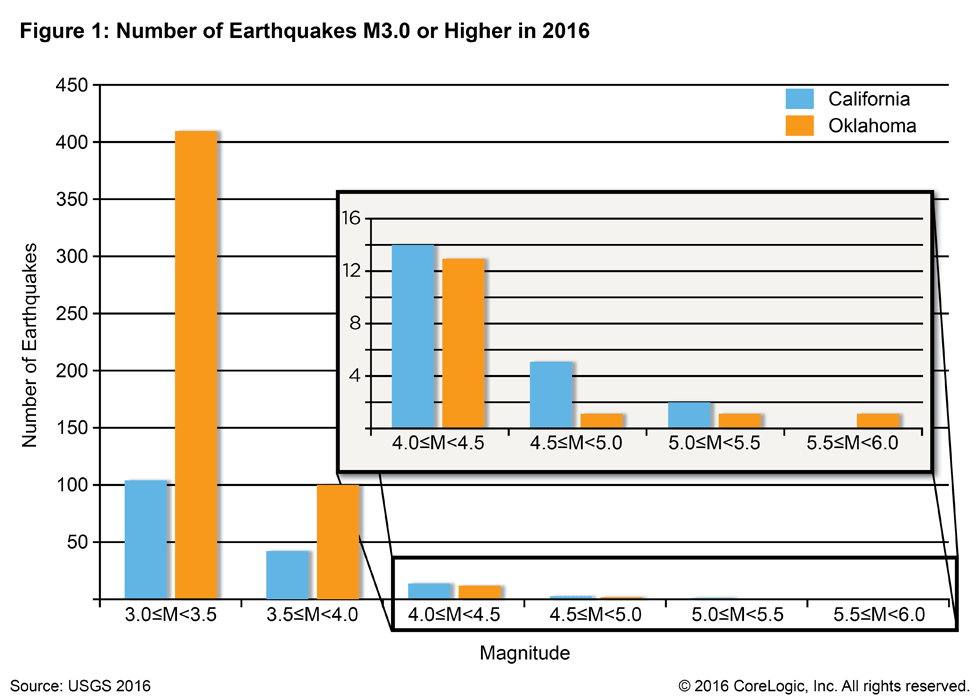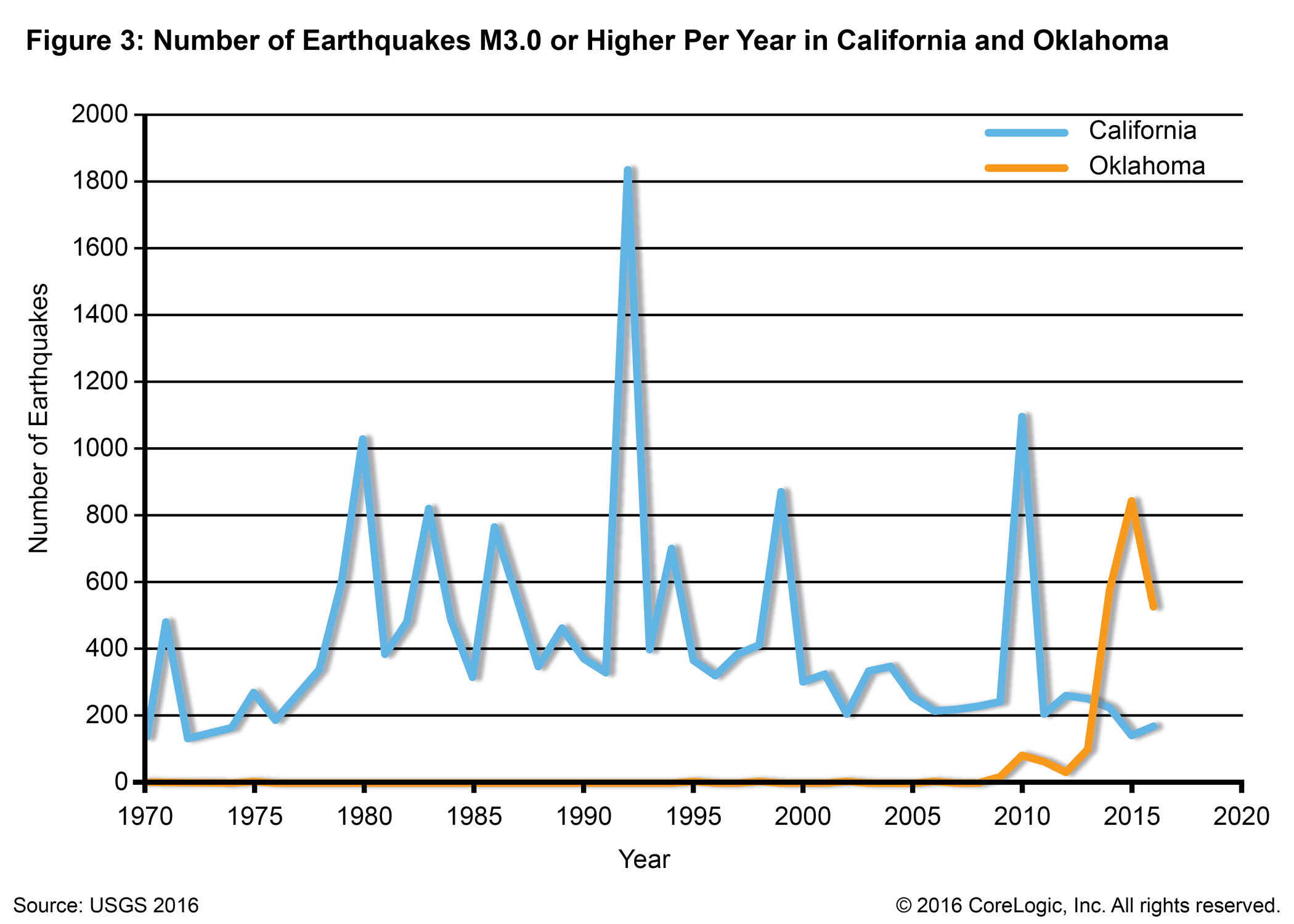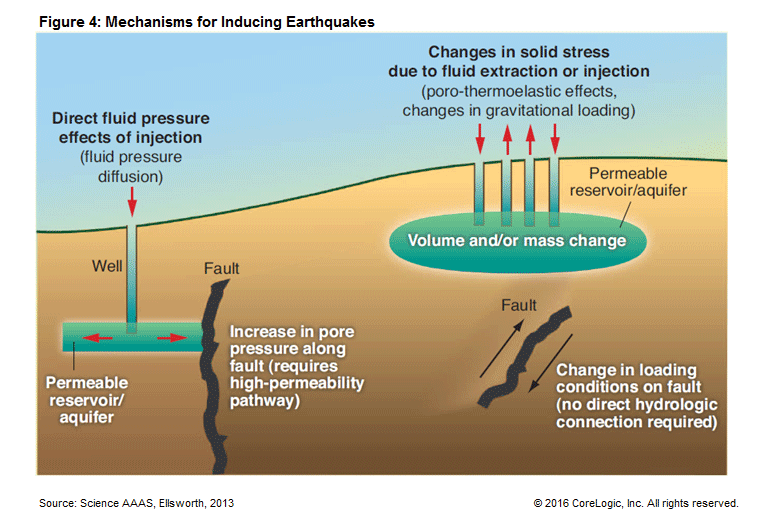Two recent data releases from CoreLogic's Insurance and Spatial Solutions division assess earthquake risk in California and Oklahoma. Yes, Oklahoma, a place normally thought of in terms of tornados risk, now outstrips California in the frequency of earthquakes. And it has achieved that dubious distinction from almost a standing start in less than a decade.
The number of earthquakes of a 3.0 magnitude or higher is nearly four times greater than in California - 528 in Oklahoma through October 6 and 169 in California. CoreLogic says this rapid increase, from an area considered to have relatively low seismic activity, is highly correlated with oil and gas exploration, specifically the hydraulic fracturing process known as "fracking."

At this point the potential for serious earthquakes is still thought to be higher in California and CoreLogic points to some new analysis that may be very disquieting to residents of that state. In a press release on Tuesday the company said that a single large earthquake could rupture simultaneously along the San Andreas fault, impacting both Northern and Southern California. This had previously been considered impossible. Further, such an occurance would cause up to 126 percent more residential property damage that previously estimated.
The San Andreas has always been considered as having two independent segments and rupture on both north and south as mutually exclusive of each other. The CoreLogic analysis, based on revised earthquake risk science from the Uniform California Rupture Forecast, Version 3 (UCERF3) now disputes that theory and finds that earthquakes of 8.0 or higher will affect a larger land area and a greater number of people. The company sets forth four scenarios, showing the increase in both the number of single family homes that could be damaged and the associated reconstruction value (RCV).
The scenarios envision full rupture earthquakes of magnitudes 8.0 to 8.3 and compares the resulting damage to previous estimates involving either a north or south event. The most severe case, an 8.3 quake affecting both segments, would increase the damage to homes by 126 percent and the RCV by 79 percent compared to one of the same magnitude affecting only the northern fault.
CoreLogic says it has been difficult to quantify the new hazard trend in Oklahoma (which is only the most extreme example of the increased seismic activity also affecting northern Texas and southern Kansas) since it is rapidly changing. Maiclaire Bolton, senior product manager, write in the CoreLogic blog that the year-over-year growth in the number of quakes is inconsist with a historic record that shows a low rate for decades. Consequently the U.S. Geologic Survey (USGS) has developed an independent, short-term view of earthquake hazard specifically related to human induced seismic activity and that has led some to believe that the earthquake hazard in Oklahoma is the highest in the nation.
To date most of the Oklahoma quakes have been small or moderate and have not caused significant damage but the potential is there for a larger event. On September 3 of this year the region experienced a 5.8 quake, the largest in Oklahoma history and the largest in the U.S. since the 2014 So Napa, California quake.
USGS data shows how rapid the rate of increased activity has been in Oklahoma compared to California. Since 1970 there have been 19,480 magnitude 3.0 or higher earthquakes in California compared with 2,299 earthquakes in Oklahoma with California's number remaining relatively constant over time except for periods when major quakes were followed by numerous aftershocks. On the other hand, Oklahoma experienced very low earthquake activity until 2009 when the rate began to rapidly increase. This increase is believed to correlate with increased fracking, the pumping of waste water at fluid injection wells.

Unlike naturally occurring, or tectonic, earthquakes, induced earthquakes result from man-made or anthropogenic causes. Both the injection and extraction of fluid can alter the fluid pressure in the pores and fractures of subsurface rocks. If this pore pressure increases significantly the imbalances in stresses can cause an induced earthquake. As pore pressure increases, the rate of quakes can also increase.

The increased occurrence of quakes has raised concerns about the risk of induced seismicity. While most earthquakes to date have been small and damage-free it is not known how much larger and how damaging they could become. USGS' 2016 report says that the potential for a large damaging event is there.
CoreLogic concludes that, while the short-term view of hazards ranks Oklahoma at the top, with its history of large damaging earthquakes and large populations exposed to the hazard, California remains the top-ranked state for overall earthquake risk.







